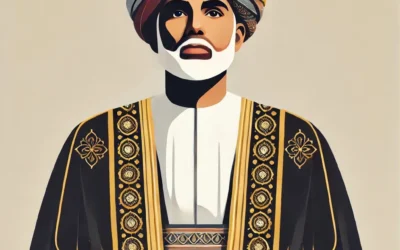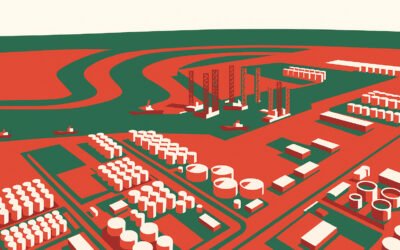Restoring the Past: Oman’s Architectural Revival
Oman is a land where history echoes through its ancient walls. From sunlit forts to finely carved wooden beams of traditional homes, the country’s architecture tells a story of resilience, craftsmanship, and a deep bond with the land. As Oman strides confidently into the future under Vision 2040, a quiet transformation is unfolding—one that seeks not just to restore historic structures but to breathe new life into them. This is the story of Oman’s architectural revival, where the past isn’t merely preserved but reimagined.
A Legacy Built from Stone and Mud
Oman’s architectural heritage is as diverse as its landscapes: In the rugged Hajar Mountains, watchtowers stand like silent sentinels over ancient trade routes. Along the coast, the whitewashed houses of Sur and Muscat reflect a maritime legacy intertwined with dhows and distant shores. In Dhofar’s villages, the scent of frankincense lingers, whispering tales of prosperity. Across the country, more than 500 forts serve as enduring symbols of a nation that has long balanced defense with diplomacy. These structures were built using local materials—mudbrick, limestone, and palm wood—designed to endure harsh conditions. Aflaj irrigation systems, dating back over 2,500 years, carried life-giving water to arid regions, while thick walls and narrow windows kept interiors cool under the desert sun. But time, weather, and modernization took their toll, leaving many of these historical treasures neglected as concrete and glass began to redefine cityscapes.
A Revival in Motion
Oman’s architectural revival is more than just restoration—it’s a movement driven by national pride and increasing global recognition. The Ministry of Heritage and Tourism, alongside local communities and international experts, has launched ambitious projects to safeguard this legacy.
Restoring Cultural Landmarks
Bait Al Zubair, Muscat – Once a family residence, this restored home now serves as a museum, offering visitors a glimpse into Omani life with its intricately carved doors and open courtyards. Nizwa Fort – A meticulously restored 17th-century fortress, where visitors can explore its massive round tower and experience its historical significance. Qalhat (UNESCO World Heritage Site) – A once-thriving port city on the frankincense trade route, its ruins, including the tomb of Bibi Maryam, have been preserved with modern visitor enhancements. The Bronze Age Tombs of Bat, Al-Khutm, and Al-Ayn – Another UNESCO-listed site, now more accessible through new pathways and signage while maintaining its ancient mystique. These projects go beyond preserving walls—they preserve stories, traditions, and Oman’s deep-rooted identity.
Blending the Old with the New
What sets Oman’s revival apart is its commitment to keeping history alive. These restorations aren’t meant to be sterile museum exhibits—they are living spaces.
Adaptive Reuse: Living in History
Misfat Al Abriyeen – A mountain village of mudbrick houses, where restored homes now serve as guesthouses, allowing visitors to experience life as it once was. Alila Jabal Akhdar Resort – A luxury retreat at 2,000 meters above sea level, blending local stone architecture with modern design.
Architectural Fusion in Urban Spaces
The Royal Opera House Muscat – A modern landmark with design elements inspired by Omani forts, including geometric patterns and grand archways. Bisya & Salut Visitor Centers – Upcoming sites designed to marry modern architecture with rugged Omani landscapes, as they push for UNESCO recognition. By integrating historical authenticity with modern functionality, Oman ensures that its heritage remains relevant and inspiring.
Why It Matters
Oman’s architectural revival is more than just aesthetics—it’s a statement of identity.
Cultural and Economic Impact
Boosting Tourism – Restored sites have significantly increased visitor numbers, drawing international recognition. Reviving Traditional Crafts – Young artisans are learning plasterwork, woodcarving, and stone masonry, ensuring that these centuries-old techniques live on. Rejuvenating Communities – Once-abandoned villages are thriving again, benefiting from heritage-driven tourism.
A Global Lesson in Sustainability
In an era where sustainability is a priority, Oman’s historic architecture offers valuable lessons: Passive cooling techniques – Thick walls, narrow windows, and internal courtyards naturally regulate temperature. Use of local materials – Eco-friendly and climate-adaptive, reducing environmental impact. Harmony with nature – Designs that blend seamlessly with landscapes rather than disrupting them. What was once a necessity is now a model for sustainable innovation.
Looking Ahead
The journey is far from over. Many historical sites still require care and attention: Bahla Fort – A sprawling mudbrick fortress needing continuous maintenance. Watchtowers of Nakhal – Overlooked structures waiting for their restoration moment. Falaj networks of Al Hamra – An ancient irrigation marvel deserving renewed focus. New UNESCO nominations – Oman is actively working toward more international heritage recognitions.
A Living History
Next time you walk through a restored Omani village or stand beneath the towering walls of a centuries-old fort, listen closely. You won’t just hear the wind—you’ll hear history whispering, alive and well in the present. Oman’s architectural revival isn’t just about restoring buildings; it’s about shaping a future that honors its rich past. And that’s a legacy worth celebrating.
I'm Hassan — a multidisciplinary storyteller at the intersection of culture, creativity, and strategy. As a content creator and website manager at Omanspire, I bring Omani stories to life through thoughtful writing, SEO-driven publishing, and engaging digital experiences. With a passion for history, branding, and visual design, I craft content that bridges tradition and innovation — always with purpose, and always with people in mind.




